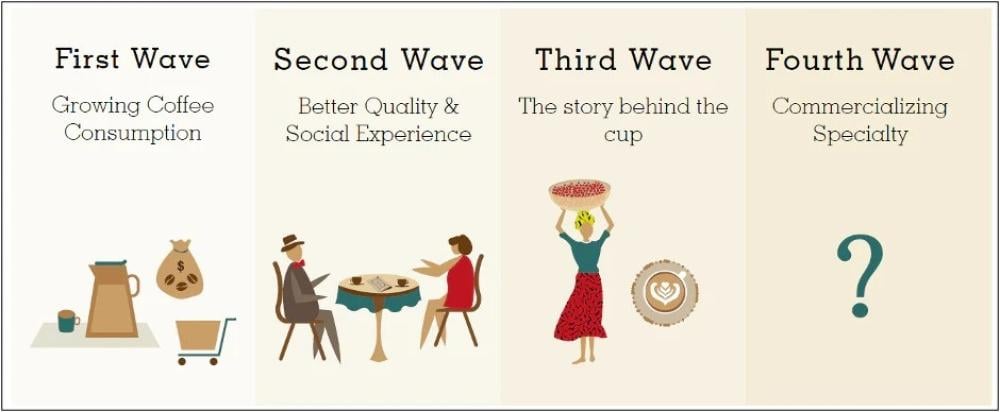Four Waves of Coffee
As the coffee industry evolved through different “waves,” people’s perceptions of it changed. The first and second waves popularized coffee as a globally traded commodity and, eventually, a household staple. These efforts were aimed at making coffee more accessible.
As coffee enters its third wave, certain standards such as quality, traceability, transparency, and renewal have been pushed to the limit. In the process, this most exclusive segment of the market has earned a reputation as “elite.”
The culture surrounding specialty coffee has come to be seen by some as exclusive or intimidating. The language and rituals of the industry have ended up alienating a broader consumer base who often couldn’t understand the high prices that specialty coffee commands.
Consumer education quickly became a prominent feature of specialty coffee, partly as a way to counter this perception of elitism and include more people. It became a priority to make end users understand specialty coffee as a complex, distinctive, and often sustainable product to justify higher prices. For more niche consumer groups, this was a welcome move.
But coffee drinkers, even in the specialty coffee category, often just want a cup of coffee, nothing more. Many feel that pushing education on the public can be arrogant when it was never asked for in the first place. Educating consumers is a delicate balance between business accountability and listening to end users.
“Continuous education is important to make coffee lovers aware of what goes on behind the cup, so that consumer awareness does not fade over time,” says Margaret Nyamombo, founder of Kahawa 1893.
Does innovation distance us from elitism?
Innovation has played a significant role in globalizing coffee consumption by transforming production, processing and distribution. However, in the specialty coffee sector, it has been innovation that has so far made it a niche category and difficult to scale.
On competition stages, barista routines become increasingly technical. Competitors showcase the latest developments in extraction theory, experimental processing techniques, etc.
There will likely always be a market for this in the real world. Innovation will continue to push specialty coffee into new areas that cater to those who are deeply involved in the sector – the elite.
However, it is clear that most coffee innovations have changed their focus. As the industry moves into the fourth wave, the main goal of innovation has become finding ways to make coffee more accessible and convenient.
“The news of the automation of global coffee competitions, for example, is controversial,” says Paul. “But it is an example of access and the fall of the walls of elitism.”
The rapid rise of the ready-to-drink (RTD) coffee market and the development of specialty coffee capsules are examples of this shift towards making specialty coffee more accessible to the mass market. The global ready-to-drink coffee market alone was valued at US$12.6 billion in 2022 and is expected to reach US$26 billion by the end of 2031.
There is always room for the "elite".
As specialty coffee enters its fourth wave, one of the key characteristics of this wave is its appeal to the masses. As the sector expands, it will have to accept becoming more accessible – and brands that don’t embrace this trend may remain “elitist,” but they will eventually be left behind.
Technology will play a significant role in making specialty coffee more accessible and less intimidating for the average consumer. As coffee machines become more autonomous and user-friendly, they could demystify much of the specialty coffee making process, reaching new demographics.
For the specialty coffee sector to be widely profitable, it needs to move away from a niche business strategy and give up some of its elitist character.
Economic pressures on disposable income are redefining consumer priorities and the way the industry operates. As prices rise, coffee roasters are spending less money on coffee, too—whether they want to or not.
The commercialization of the specialty coffee sector is inevitable in light of this change. While the “elite” and its niche market will still exist, it will not have the opportunity to grow beyond its current size unless it takes into account concessions on valuations and lower prices.

